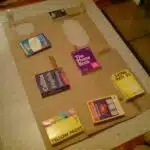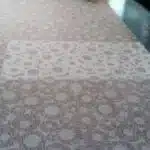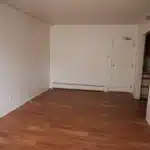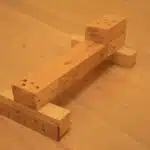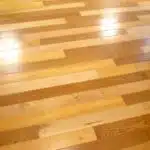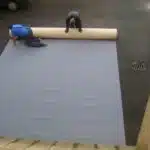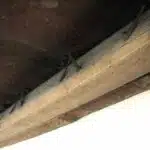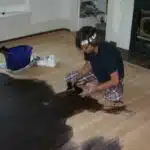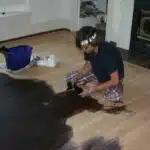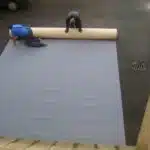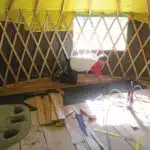Carpet removal can be a daunting task, especially if you have no prior experience. However, it is not impossible to remove carpet without professional help. With the right tools and techniques, you can successfully remove your old carpet and prepare your floor for new flooring.
As a DIY carpet removal expert, I understand the challenges that come with this process. Whether you are looking to replace your carpet with hardwood or laminate flooring or simply want to upgrade your current carpeting, removing the old carpet is the first step towards achieving your goals. In this article, I will provide you with tips and tricks for removing carpet without professional help. By following these steps, you will save yourself money and gain valuable knowledge that can be used for future home improvement projects.
Gather The Necessary Tools
Removing a carpet may seem like a daunting task, but with the right tools and safety precautions, it can be done without professional help. Before starting the process, gather all the necessary tools to ensure that the job is done efficiently. Some of the important tools required for removing a carpet include gloves, safety glasses, dust masks, utility knife or carpet cutter, pry bar or claw hammer, pliers or locking pliers, and a vacuum cleaner.
Choosing appropriate tools is crucial for ensuring a safe and efficient carpet removal process. Gloves protect your hands from sharp edges and debris while safety glasses shield your eyes from flying particles. A dust mask helps you breathe clean air by filtering out dust and other airborne particles. A utility knife or carpet cutter is necessary for cutting through the carpet while a pry bar or claw hammer helps in pulling up the tacks along the edges of the room. Pliers or locking pliers come in handy when removing stubborn staples from the floorboards.
It is essential to take safety precautions during carpet removal to prevent injuries. Wear protective gear such as gloves, safety glasses, and dust masks to avoid cuts, eye injuries from flying debris, and respiratory problems due to inhaling dust particles. Additionally, remove any furniture or objects that could pose tripping hazards during work. By taking these precautions and using appropriate tools, you can safely remove a carpet without professional help.
With all necessary tools gathered and safety measures taken into consideration, it’s time to prepare the room for carpet removal by clearing out any obstacles that could hinder progress.
Prepare The Room For Carpet Removal
After gathering the necessary tools, the next step in removing carpet without professional help is to prepare the room for removal. This involves clearing the area of any furniture or obstacles that may get in the way during removal. Before starting, it’s important to have a plan and strategy in mind to ensure a smooth and efficient process.
Tools needed for preparing the room include gloves, safety glasses, knee pads, and a dust mask. It’s important to protect yourself from potential hazards such as sharp objects or dust particles. Additionally, you’ll need a utility knife or carpet cutter to cut the carpet into smaller sections for easier removal. A pry bar or pliers will also be useful for pulling up any tack strips or staples that are holding down the carpet.
Once you’ve gathered your tools and cleared the area, it’s time to begin preparing the room. Start by removing any baseboards or trim around the edges of the room to expose any hidden staples or tack strips. Using your utility knife or cutter, score along the edges of each section of carpet and then cut it into manageable pieces that can be easily lifted and carried out of the room. As you remove each piece of carpet, make sure to roll it up tightly so that it doesn’t take up too much space in your disposal bags.
Next section: Clearing The Area
Clear The Area
Clearing the space before removing your carpet is an essential first step. You don’t want to trip over any furniture or miscellaneous items that may be lying around. Additionally, having a clear area will make it easier to roll up the carpet and dispose of it once you’re done. Start by moving all the furniture out of the room, or at least to one side of the room if it’s too heavy to move completely. This includes chairs, tables, sofas, and anything else that might impede your progress.
In addition to clearing space, safety precautions should also be taken seriously when removing your carpet. First, wear gloves to protect your hands from any sharp objects that may be hidden in the carpet fibers. Second, put on a mask to avoid inhaling any dust or debris that might be released during the removal process. Lastly, make sure you have appropriate footwear with good grip to prevent slipping.
Once you’ve cleared the area and taken necessary safety precautions, you’re ready to start removing your carpet! But before we get there, let’s recap: Clearing space and taking safety precautions are crucial steps in preparing for DIY carpet removal. By doing so, you’ll have a safer and more efficient experience while also protecting yourself from unnecessary harm. In our next section, we’ll discuss how to cut your carpet into manageable sections for easy removal without damaging floors or walls.
Cut The Carpet Into Manageable Sections
Using a Carpet Knife:
Now that you have removed any furniture from the room, it is time to start cutting the carpet into manageable sections. The first step in this process is to grab your carpet knife. This tool is specifically designed to cut through carpets and make the process much easier.
Begin by finding a corner of the room and cutting a small section of the carpet away from the wall, using your carpet knife. Then, slowly work your way across the room, cutting strips of carpet into manageable sizes. Be sure to use caution when cutting and avoid damaging any underlying flooring.
Disposing of Waste:
As you cut each section of carpet away, be sure to roll it up tightly and tie it with string or tape before disposing of it properly. Most cities have specific guidelines for disposing of large items like carpets, so be sure to check with your local waste management company before throwing anything away.
Remember that carpets can be very heavy, especially if they are wet or have padding attached. If you are unable to lift or move large sections on your own, consider reaching out to a friend or hiring professional help.
Transition:
Now that you have successfully cut your carpet into manageable sections and disposed of waste correctly, it’s time to move onto removing the tack strips. This next step will require some additional tools and techniques but can be easily accomplished with some patience and persistence.
Remove The Tack Strips
After cutting the carpet into manageable sections, the next step in removing it without professional help is to remove the tack strips. These narrow wooden boards are attached to the floor around the edges of a room and hold the carpet in place with small nails or tacks. Removing them can be tricky, but with a few tips and tricks, anyone can do it themselves.
First, use a flat pry bar or chisel to loosen one end of the tack strip. Then, gently tap it with a hammer until it starts to lift off the floor. Once you have an edge that’s loose enough to grip, grab it with pliers and pull up at an angle. Be careful not to damage your flooring as you work your way around the room.
Once all of the tack strips have been removed, it’s time to dispose of your old carpet properly. Depending on where you live, there may be specific regulations for how to get rid of carpeting. In general, though, you’ll want to roll up your old carpet and cut it into smaller pieces that will fit into garbage bags or your local trash pickup’s guidelines. If you’re disposing of a large amount of carpeting, consider renting a dumpster or contacting a waste removal service for assistance.
- Tips for removing stubborn tack strips:
- Use a heat gun or hair dryer to soften any adhesive underneath the strip.
- Wedge a putty knife under one end of the strip and tap it gently with a hammer.
- Apply pressure with pliers as you pull up on one end of the strip.
- Work slowly and carefully around corners and tight spaces.
With these tips in mind, removing tack strips should be relatively simple – even if they’re particularly stubborn! Next up: How to remove carpet padding without professional help.
Remove The Carpet Padding
To remove the carpet padding, you will need a few tools to make the process easier. These include a utility knife, pliers, gloves, and a dust mask for safety purposes. You may also want to use a pry bar if the padding is stapled down.
Start by cutting the padding into manageable pieces with your utility knife. Once you have cut through it, use your pliers to pull it up from the floor. Be sure to wear gloves as you handle the padding because it can be dirty and full of allergens. If any parts of the padding are still stuck to the floor, use your pliers or pry bar to gently lift them away.
Now that you have removed both the carpet and padding, it’s time to think about disposal options. Depending on where you live, there may be different regulations for how these items can be disposed of. Check with your local waste management facility to see if they offer pick-up services for large items like carpets or if there are any drop-off locations nearby. Be sure to follow all guidelines for proper disposal so that you can dispose of everything safely and responsibly.
| Tools Needed | Disposal Options |
|---|---|
| Utility Knife | Waste Management |
| Pliers | Pick-Up Services |
| Gloves | Drop-Off Locations |
| Dust Mask | |
| Pry Bar |
As we’ve seen, removing carpet padding is not too difficult when you have the right tools and know-how. By following these steps carefully, you should be able to remove both carpet and padding without professional help. Now that everything is removed from your floors, let’s move on to disposing of them properly in order to avoid any environmental issues in our community.
Dispose Of The Carpet And Padding
After successfully removing your carpet and padding, it is important to dispose of them properly. One eco-friendly option is to recycle the carpet and padding if possible. However, not all recycling centers accept carpet and padding due to their size and composition. It is best to check with your local recycling center beforehand.
Another option for disposing of your old carpet and padding is to donate them to a local charity or non-profit organization. Many organizations accept gently used carpets and pads for those in need. This not only helps someone in the community but also reduces waste in landfills.
If neither recycling nor donating are viable options, the last resort is to dispose of the carpet and padding at a landfill or through curbside pickup. However, it is important to check with your local waste management agency for proper disposal procedures as some materials may require special handling.
To ensure a clean surface, it is necessary to remove any remaining carpet adhesive before installing new flooring. There are several methods for removing adhesive including using a scraper, heat gun, or chemical remover. Each method has its own advantages and disadvantages depending on the type of adhesive used and the condition of the subfloor. It is essential to research each method thoroughly before proceeding with adhesive removal.
Remove Any Remaining Carpet Adhesive
As the carpet has been removed, the next step is to deal with any remaining adhesive that may be stuck to the subfloor. This can be a tedious and time-consuming process, but it is essential for ensuring that the new flooring can adhere properly.
Scraping techniques are one of the most popular ways to remove carpet adhesive. A simple scraper or putty knife can be used to scrape away at the adhesive until it is completely removed. It is important to note that this method may take longer than others, but it is safer and does not require any chemical solvents.
If scraping does not work, then chemical solvents can be used as an alternative. These solvents are designed specifically to dissolve carpet adhesive, making it easier to remove. However, they can be harsh and should only be used in well-ventilated areas with proper protective gear. Be sure to follow all safety precautions and manufacturer instructions when using these chemicals.
With any remaining adhesive removed from the subfloor, it’s time to move on to cleaning. In order for the new flooring material to adhere properly, you must ensure that the subfloor is clean and free of debris. This involves sweeping or vacuuming up any loose particles and then scrubbing down the surface with a mild detergent solution. Once this is complete, you’ll be ready to install your new flooring material without any issues!
Clean The Subfloor
To begin the process of removing carpet from a subfloor, it is important to start by thoroughly vacuuming the carpet to remove any dirt and debris that may be present.
Once the carpet has been vacuumed, the next step is to remove the adhesive that was used to secure the carpet to the subfloor.
To remove the adhesive, it is necessary to use a suitable solvent or remover that is designed for the specific adhesive used on the carpet.
In some cases, it may also be necessary to use a heat gun to soften the adhesive, depending on the type of adhesive and how long it has been in place.
Vacuum Carpet
When it comes to removing carpet, one of the first steps is to clean the subfloor. Before you can begin, it’s important to deep clean the carpet with a quality vacuum cleaner. Not all vacuums are created equal, so selecting the right one for your specific needs is crucial.
To effectively deep clean carpets, look for a vacuum that has strong suction power and multiple attachments for different surfaces and debris types. A HEPA filter is also important to capture small particles and allergens. Consider renting a professional-grade vacuum from a home improvement store if you don’t have one at home.
When using your chosen vacuum, make sure to go over each area of the carpet multiple times in different directions to ensure all dirt and debris is removed. Don’t forget to focus on areas around furniture and baseboards where dust tends to accumulate. Once you’ve thoroughly cleaned your carpet, you’re ready to move on to removing it from the subfloor.
Remove Adhesive
After deep cleaning the carpet, the next step to prepare for removing it is to remove any adhesive that may be on the subfloor. This can be a challenging task as adhesives are designed to stick and hold firmly onto surfaces. However, there are useful techniques and effective products that can make this process easier.
One of the most common methods of removing carpet adhesive is using a scraper or putty knife to scrape away as much of the adhesive as possible. This can be a time-consuming process and may require multiple passes over the same area. Additionally, if there are any stubborn spots, using a heat gun or chemical adhesive remover may help soften the adhesive for easier removal.
Once you have removed as much adhesive as possible, it’s important to thoroughly clean and prep the subfloor before installing new flooring. This includes sweeping or vacuuming up any remaining debris and wiping down the surface with a damp cloth to ensure it’s free of dust and debris. With these steps completed, you’re now ready to move on to installing new flooring in your space.
Inspect The Subfloor For Damage
Now that you have cleaned the subfloor, it’s time to inspect it for damage before removing the carpet. Checking for moisture is crucial because it can cause further damage to the floor if left unaddressed. Use a moisture meter to determine if there are any damp spots or high levels of humidity in the subfloor. If there is, you need to allow the subfloor to dry completely before proceeding with the removal.
After checking for moisture, assess the condition of your subfloor. Look for any cracks, holes, or unevenness in your floorboards. If you notice any signs of damage, take note of them and make necessary repairs before removing your carpet. This will prevent further damage and ensure that your new flooring will be installed correctly.
To summarize this section, here is a list of things you need to do when inspecting your subfloor for damage:
- Use a moisture meter to check for damp spots or high levels of humidity.
- Assess the condition of your subfloor by looking for cracks, holes, or unevenness.
- Make necessary repairs before removing your carpet.
Once these steps are completed thoroughly, you can move on to repairing any damage to your subfloor before installing new flooring.
Repair Any Damage To The Subfloor
Now that you have successfully removed your carpet without professional help, it is time to assess any damage that may have occurred to the subfloor. It is not uncommon for subfloors to suffer from water damage, mold, or even wood rot, especially if the carpet has been installed for a long time. Before proceeding with any new flooring installation, it is vital to repair any damage that may be present on the subfloor.
There are several repair techniques available for fixing subfloor damage. The first step is to remove any damaged sections of the subfloor material and replace them with new ones. Depending on the level of damage, you may have to remove large portions of the subfloor. Once you have removed all damaged areas, you can proceed with installing new materials.
Subfloor materials vary widely in terms of durability and cost. Plywood is one of the most common and affordable options available today. It comes in different thicknesses and grades, making it an ideal choice for most subfloor repairs. Other popular options include cement board and oriented strand board (OSB). Keep in mind that each material has its own advantages and disadvantages, so it’s crucial to do your research before selecting one that suits your needs best.
Now that we have discussed various repair techniques and subfloor materials let’s move on to the next section – installing new flooring. With a properly repaired and prepped subfloor, you can now proceed with confidence knowing that your new floor will be sturdy enough to withstand everyday wear and tear. So let us dive into how to install new flooring like a pro!
Install New Flooring
Now that the carpet has been removed, it’s time to decide on new flooring options. There are several different types of flooring to choose from, including hardwood, laminate, vinyl, and tile. Each option comes with its own set of benefits and drawbacks, so it’s important to carefully consider which one will work best for your space.
One factor to consider when choosing new flooring is cost. Hardwood can be more expensive upfront but may add value to your home in the long run. Laminate and vinyl are often more budget-friendly options but may not last as long as hardwood or tile. It’s important to weigh the pros and cons of each option and find a balance between cost and quality.
Ultimately, installing new flooring can be a rewarding DIY project for those willing to put in the time and effort. However, difficult situations such as uneven subfloors or complex layouts may require professional help. Consider hiring a reputable contractor for these situations to ensure the job is done correctly and safely.
Consider Hiring A Professional For Difficult Situations
Although removing carpet may seem like a simple task, it can quickly become overwhelming and difficult for those without experience. While DIY carpet removal can save you money, it is important to consider hiring a professional for more challenging situations.
DIY vs Professional: The choice between DIY carpet removal and hiring a professional ultimately boils down to the complexity of the job. Small rooms with minimal furniture are ideal for DIY carpet removal projects. However, larger rooms with heavy furniture or complex layouts may require the expertise of a professional. Additionally, professionals have access to specialized equipment that makes the job easier and faster.
Cost Comparison: Hiring a professional for carpet removal may seem expensive at first glance, but it is important to consider the long-term costs. Professionals are less likely to make mistakes that could damage your flooring or walls, which could end up costing you more in repairs. Additionally, professionals can dispose of old carpeting in an environmentally friendly way, saving you time and hassle.
Transition sentence: Now that we have explored the benefits of hiring a professional for difficult carpet removal projects, let’s move on to some tips for making DIY carpet removal easier and more efficient.
Tips For Easier Carpet Removal
Metaphorically speaking, removing carpet can be compared to peeling off a band-aid – it may be painful, but it has to be done. DIY carpet removal can save you a lot of money and give you the satisfaction of completing a home improvement project on your own. Here are some tips for an easier carpet removal experience:
Gather the necessary tools: Before getting started, make sure you have all the tools required for the job. You will need gloves, pliers, utility knife, pry bar, and a dust mask.
Cut the carpet into manageable sections: Use a utility knife to cut the carpet into smaller sections that you can easily roll up and dispose of.
Pull up the carpet: Once you have cut the carpet into sections, use pliers or a pry bar to pull it up from one corner of the room. It’s important to work slowly and carefully to avoid damaging the subfloor.
Dispose of old flooring responsibly: After removing the old carpets, consider eco-friendly disposal options like donating them or recycling them rather than just throwing them away.
DIY carpet removal is not rocket science; with patience and persistence, anyone can do it successfully. Once you’ve removed your old carpets, there are many affordable flooring options available in the market such as laminate flooring or vinyl plank flooring that can give your home an instant facelift without breaking your budget. In conclusion, with these tips in mind, you’ll be well on your way to enjoying new floors in no time!
Conclusion
Now that you have learned some useful tips for easier carpet removal, let’s discuss whether DIY or professional carpet removal is the better option. While hiring professionals can save you time and effort, it can also be quite expensive. On the other hand, removing carpet yourself may take longer and require more physical labor, but it can also save you money.
If you decide to remove your carpet yourself, there are some common mistakes that you should avoid. First, make sure to use the right tools for the job. This includes a utility knife for cutting the carpet and a pry bar for removing tack strips. Additionally, be careful not to damage the subfloor when removing staples or glue residue.
Another mistake to avoid is not properly disposing of the old carpet and padding. Make sure to check with your local waste management facility for guidelines on how to properly dispose of these materials. Finally, remember to wear protective gear such as gloves and a mask while working with carpet due to potential dust exposure.
In conclusion, whether you choose DIY or professional carpet removal depends on your budget and time constraints. If you have little experience in home improvement projects or simply don’t have the time or physical ability to do so, hiring professionals may be worth the investment. However, if you’re willing to put in some extra effort and want to save money, removing your own carpet is definitely doable with some preparation and patience.
Conclusion
Removing a carpet without professional help can be a daunting task, but with the right tools and preparation, it is achievable. The first step in removing your carpet is to gather the necessary tools such as gloves, pliers, a utility knife, and a pry bar. Afterward, prepare the room by removing all furniture and ensuring that there are no nails or screws on the floor that could damage your new flooring.
Once the room is prepared, clear the area by ripping out any old padding and cutting the carpet into manageable sections. Then remove the tack strips using pliers or a pry bar and dispose of them properly. Finally, install your new flooring and enjoy your newly renovated space.
It’s important to note that while DIY carpet removal may save you money, some situations may require professional assistance. For instance, if you encounter mold or asbestos during the removal process, it’s best to hire professionals who have experience dealing with hazardous materials.
In conclusion, removing a carpet without professional help requires patience and attention to detail. By following these steps and utilizing proper safety precautions, you can successfully remove your old carpet and install new flooring. Remember to consider hiring professionals for difficult situations and always prioritize safety over cost-cutting measures. As Thomas Edison once said,”Opportunity is missed by most people because it is dressed in overalls and looks like work.” So roll up your sleeves and let’s get started!
Image Credits
- “Portrait of Jurka Shutenko on the background of the carpet and remove the old windows” by misha maslennikov (featured)



